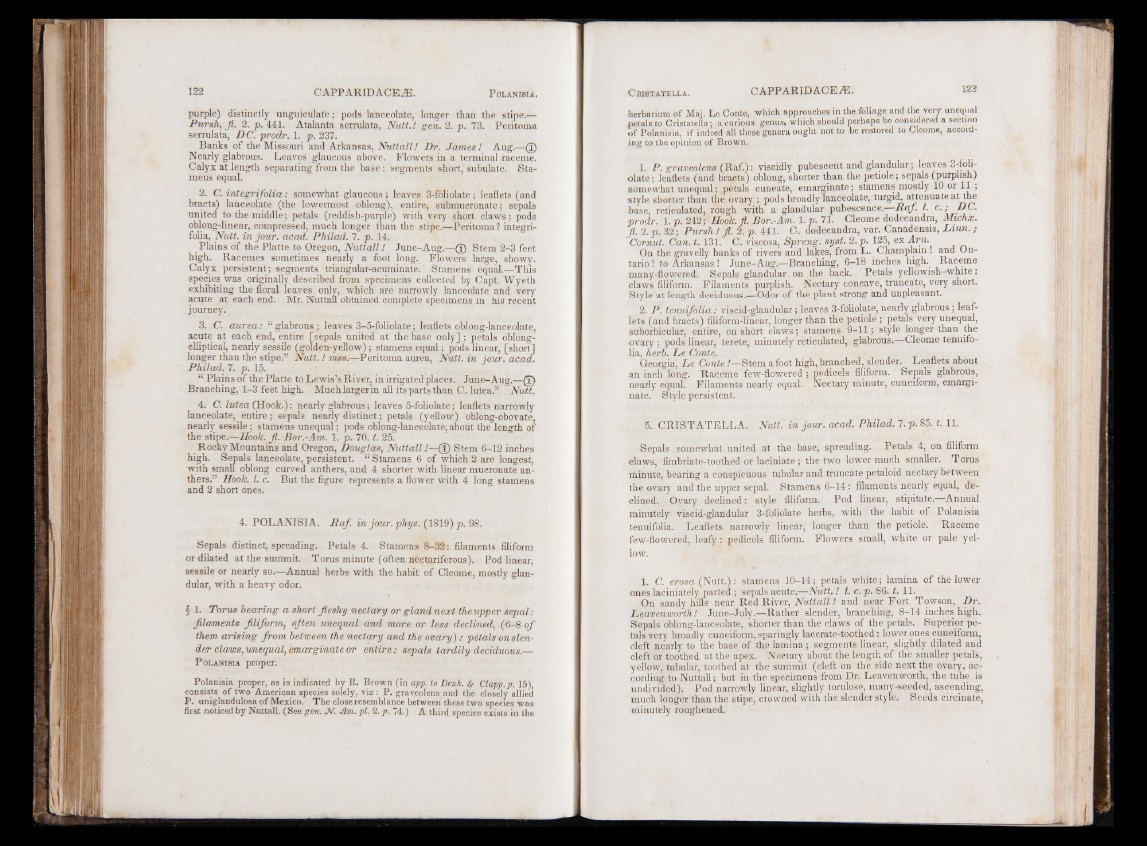
purple) distinctly unguiculate; pods lanceolate, longer than the stipe.—
Pursh, fi. 2. p. 441. Atalanta serrulata, Nutt.! gen. 2. p. 73. Peritoma
serrulata, DC. prodr. 1. p. 237.
Banks of the Missouri and Arkansas, Nuttall! Dr. James ! Aug.—(3)
Nearly glabrous. Leaves glaucous above. Flowers in a terminal raceme.
Calyx at length separating from the base : segments short, subulate. Stamens
equal.
2. C. integrifolia: somewhat glaucous; leaves 3-foliolate ; leaflets (and
bracts) lanceolate (the lowermost oblong), entire, submucronate; sepals
united to the middle ; petals (reddish-purple) with very short claws; pods
oblong-linear, compressed, much longer than the stipe.—Peritoma? integrifolia,
Nutt, in jour. acad. Philad. 7. p. 14.
Plains of the Platte to Oregon, Nu tta ll! June-Aug.—(J) Stem 2-3 feet
high. Racemes sometimes nearly a foot long. Flowers large, showy.
Calyx persistent; segments triangular-acuminate. Stamens equal.—This
species was originally described from specimens collected by Capt. Wyeth
exhibiting the floral leaves only, which are narrowly lanceolate and very
acute at each end. Mr. Nuttall obtained complete specimens in his recent
journey.
3. C. aurea: “ glabrous; leaves 3-5-foliolate; leaflets oblong-lanceolate,
acute at each end, entire [sepals united at the base only] ; petals oblong-
elliptical, nearly sessile (golden-yellow); stamens equal; pods linear, [short]
longer than the stipe.” N u tt.! mss.—Peritoma aurea, Nutt, in jour. acad.
Philad. 7. p. 15.
“ Plains of the Platte to Lewis’s River, in irrigated places. June-Aug.—©
Branching, 1-3 feet high. Muchlargerin all its parts than C. lutea.” Nutt.
4. C. lutea (Hook.): nearly glabrous; leaves 5-foliolate; leaflets narrowly
lanceolate, entire; sepals nearly distinct; petals (yellow) oblong-obovate,
nearly sessile; stamens unequal; pods oblong-lanceolate, about the length of
the stipe.—Hook. jl. Bor.-Am. 1, p. 70. t. 25.
Rocky Mountains and Oregon, Douglas, Nu tta ll!—(5) Stem 6-12 inches
high. Sepals lanceolate, persistent. “ Stamens 6 of which 2 are longest,
with small oblong curved anthers, and 4 shorter with linear mucronate anthers.”
Hook. 1. c. But the figure represents a flower with 4 long stamens
and 2 short ones.
4. POLANISIA. Raf. in jour. phys. (1819) p. 98.
Sepals distinct, spreading. Petals 4. Stamens 8-32: filaments filiform
or dilated at the summit. Torus minute (often nectariferous). Pod linear,
sessile or nearly so.—Annual herbs with the habit of Cleome, mostly glandular,
with a heavy odor.
§ 1. Torus bearing a short Jleshy nectary or gland next the upper sepal:
jilamente filiform, often unequal and mare or less declined, (6-8 o f
them arising from between the nectary and the ovary) : petals on slender
claws, unequal, emarginate or entire: sepals tardily deciduous.—
P olanisia proper.
Polanisia proper, as is indicated by R. Brown (in app. to Penh. <$• Clapp, p. 15),
consists of two American species solely, viz: P. graveolens and the closely allied
P. uniglandulosa of Mexico. The close resemblance between these two species was
first noticed by Nuttall. (See gen. Jf. Jim. pi, 2. p. 74.) A third species exists in the
herbarium of Mai. Le Conte, which approaches in the foliage and the very unequal
petals to Cristatella; a curious genus, which should perhaps be considered a section
of Polanisia, if indeed all these genera ought not to be restored to Cleome, accord-
ing to the opinion of Brown.
1. P. graveolens (Raf.): viscidly pubescent and glandular; leaves 3-foh-
olate; leaflets (and bracts) oblong, shorter than the petiole; sepals (purplish)
somewhat unequal; petals cuneate, emarginate; stamens mostly 10 or 11 ;
style shorter than the ovary ; pods broadly lanceolate, turgid, attenuate atThe
base, reticulated, rough with a glandular pubescence.—Raf. 1. c.; DC.
prodr. l.p . 242; Hook.fi. Bor.-Am. l.p . 71. Cleome dodecandra, Michx.
fi. 2. p. 32; Pursh ! fi. 2. p. 441. C. dodecandra, var. Canadensis, L in n .;
Cornut. Can. t. 131. C. viscosa, Spreng. syst. 2. p. 125, ex Arn
On the gravelly banks of rivers and lakes, from L. Champlain . and Ontario
! to Arkansas! June-Aug.—Branching, 6-18 inches high. Raceme
many-flowered. Sepals glandular on the back. Petals yellowish-white:
claws filiform. Filaments purplish. Nectary concave, truncate, very short.
2. P. tenuifolia: viscid-glandular; leaves 3-foliolate, nearly glabrous ; leaflets
(and bracts) filiform-linear, longer than the petiole; petals very unequal,
suborbicular, entire, on short claws; stamens 9-11; style longer than the
ovary ; pods linear, terete, minutely reticulated, glabrous.—Cleome tenuifolia,
herb. Le Conte.
Georgia, Le Conte !—Stem afoot high,branched, slender. Leaflets about
an inch long. Raceme few-flowered ; pedicels filiform. Sepals glabrous,
nearly equal. Filaments nearly equal. Nectary minute, cuneiform, emarginate.
Style persistent.
5. CRISTATELLA. Nutt, in jour. acad. Philad. 7. p. 85. t. 11.
Sepals somewhat united at the base, spreading. Petals 4, on filiform
claws, fimbriate-toothed or laeiniate ; the two lower much smaller. Torus
minute, bearing a conspicuous tubular and truncate petaloid nectary between
the ovary and the upper sepal. Stamens 6-14: filaments nearly equal, declined.
Ovary declined: style filiform. Pod linear, stipitate. Annual
minutely viscid-glandular 3-foliolate herbs, with the habit of Polanisia
tenuifolia. Leaflets narrowly linear, longer than the petiole. Raceme
few-flowered, leafy: pedicels filiform. Flowers small, white or pale yellow.
1. C. erosa (Nutt.) : stamens 10-14; petals white; lamina of the lower
ones laciniately parted ; sepals acute.—Nu tt.! 1. c. p. 86. t. 11.
On sandy hills near Red River, N u tta ll! and near Fort Towson, Dr.
Leavenworth! June-July.—Rather slender, branching, 8-14 inches high.
Sepals oblong-lanceolate, shorter than the claws of the petals. Superior petals
very broadly cuneiform, sparingly lacerate-toothed: lower ones cuneiform,
cleft nearly to the base of the lamina; segments linear, slightly dilated and
cleft or toothed at the apex. Nectary about the length of the smaller petals,
yellow, tubular, toothed at the summit (cleft on the side next the ovary, according
to Nuttall; but in the specimens from Dr. Leavenworth, the tube is
undivided). Pod narrowly linear, slightly torulose, many-seeded, ascending,
much longer than the stipe, crowned with the slender style* Seeds circinate,
minutely roughened.